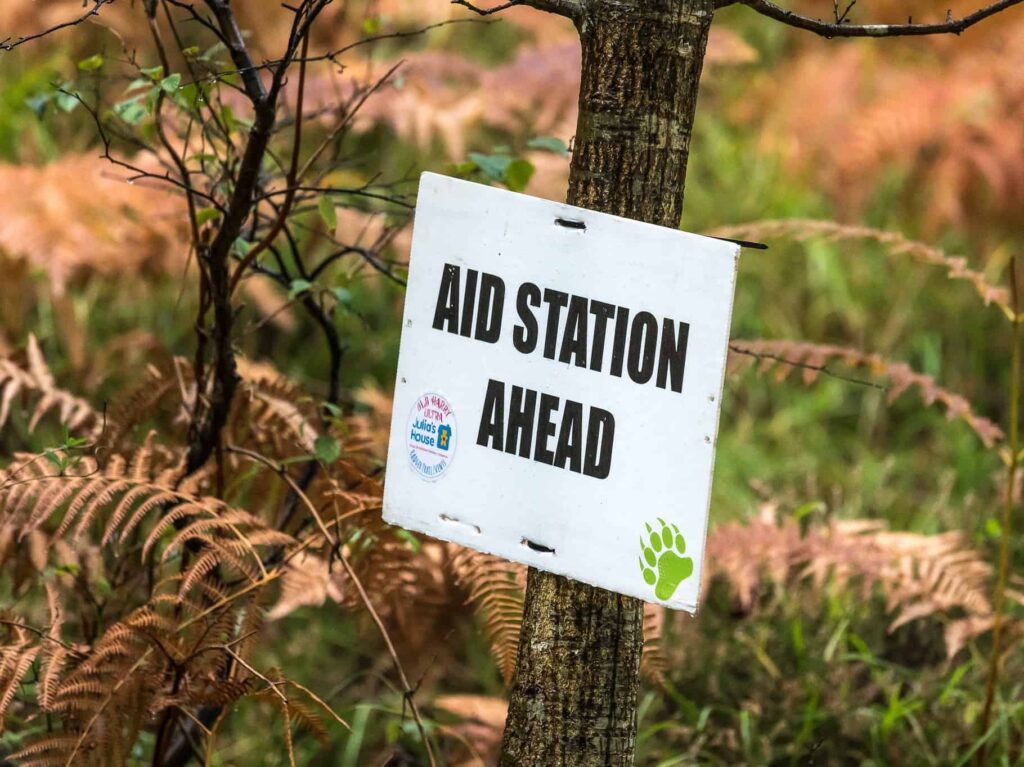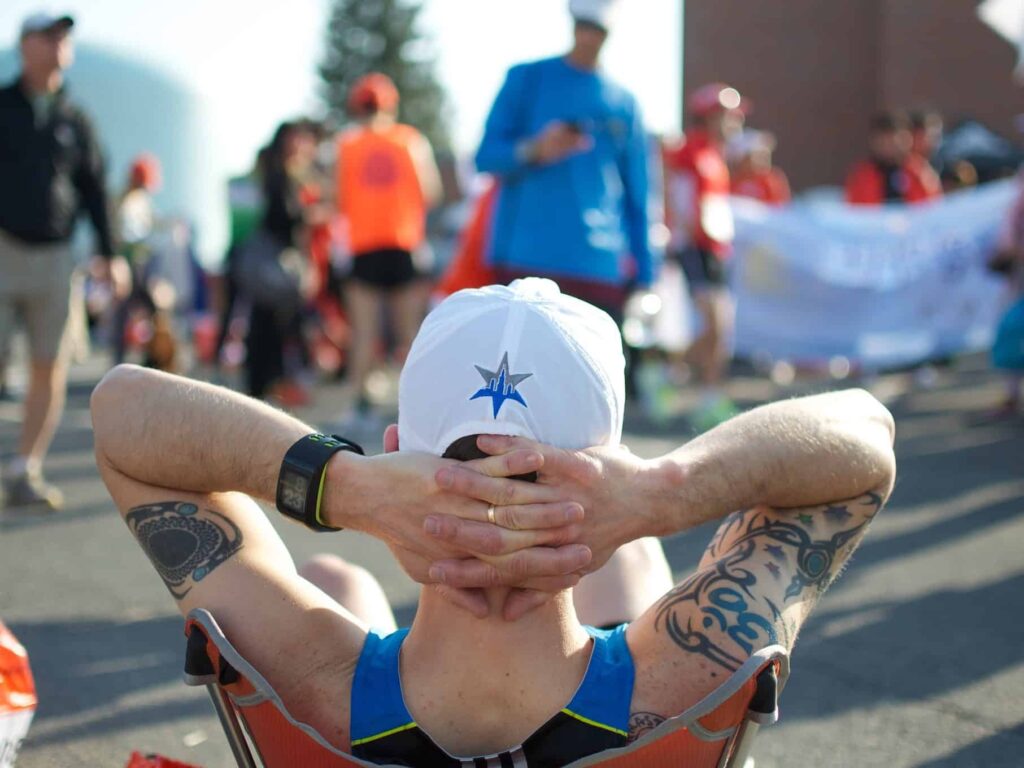Last updated on January 17th, 2023 at 07:33 pm
Elite ultrarunners often run upwards of twenty-four hours straight while simultaneously consuming thousands of calories. It’s just a given that And, eventually the body needs to relieve itself. So, we’ll help answer the question, ‘where and how do ultrarunners go to the bathroom,’ as it is a large part of navigating such an intense race. And, we’ll explain in detail the ins and outs of everything you need to know.
From porta-potties to darting off the trail, there are actually a variety of toileting options for ultramarathon runners. Plus, the laid-back attitude of an ultra makes it easier.
Are There Toilets During a Marathon?
Luckily, almost all ultras and marathons have porta-potties located throughout the course.
In most cases, porta-johns are stationed every two to three miles and at aid stations.
Unfortunately, though, you can’t always make it to the next latrine. Therefore, it’s not uncommon to see runners slip off the trail to the nearest tree or bush.
Just remember, without your own tissue or wipes, you’ll be grasping for leaves. For this reason, many runners carry TP, wipes, baggies, and sanitiser with them while they run.
Leave no trace applies to ultramarathoning too. So, be prepared!
This information is usually provided by the race hosts when you sign up.
It’s always a good idea to review this information before race day so you have an idea of where everything is located.
Like most public events, however, the lines can get pretty long.
Additionally, we all know how gross porta-Johns become over extended periods of time. So, being prepared is always your best bet.
Most Runners Train for Toilet Breaks Months in Advance, Here are Their Strategies:
Firstly, every runner has their own way of doing things, so it’s important to ensure you’re doing what’s best for you.
In fact, many runners begin training their digestive system months in advance of their next ultra. Humans are, after all, creatures of habit. From when we wake up to when we eat to even when we poo, things happen on a schedule.
Typically, runners train by developing a regimen of when they eat to determine the timing of their BMs.
1. Runners Avoid Certain Foods that Upset the Stomach
Plus, it is also important to be very selective about what you eat the night before a race.
For instance, refrain from consuming these the night before and the morning before your race to avoid emergency toilet breaks:
- Fiber-rich foods like fruits, vegetables, and whole grains
- Fatty foods
- Spicy foods
- Don’t carb-load at the last minute
Additionally, eating slightly less the night before and waking up extra early on the day of the race allows plenty of time for bathroom needs.
2. Some Runners Even Limit Water Intake
Likewise, many runners even limit their water intake.
Since so much fluid is lost through sweat, some runners only drink what they need to stay hydrated. Thus, eliminating the need to urinate.
Furthermore, we’ve found the Best Hydration Vests for Trail Running and Ultrarunning in this post to help ultrarunners balance hydration, store emergency toilet break supplies, and stash gels.

3. Ultrarunners Eat Breakfast Well Before Start Time
Experienced runners recommend eating two to three hours before an ultra to give the digestive system plenty of time to run its course.
Now, while food takes about 36- 72 hours to pass through your digestive system, eating early helps avoid belly upset and runners trots.
And, of course you’ll almost always relieve yourself just before the race.
However, sometimes all the planning and training in the world won’t quite work out the way we hope. And, when you’re running for more than 24 hours straight, eventually, you need to go.
Do Ultrarunners Eat During Ultra Marathons?
Yes, ultrarunners will inevitably need to refuel as they conquer multiple hours of track. Most utilize whole foods that incorporate protein, caffeine or sugar. But many also consume gel packs. In fact, if you’re planning to run an ultra, check out our post, How Should Gels be Spaced during Ultramarathons.
Ultrarunners often consume full-fledged meals while on the run (or standing at aid stations) to make up large calorie stores that are depleted throughout the race.

Do Marathon Runners Pee and Poop Themselves? Where and How Do Ultrarunners Go to the Bathroom
Unfortunately, accidents do happen during marathons and ultras. Experienced runners confess it’s not glamorous, but by the same token, it’s no big deal either. In fact, running an ultra is a humbling experience. And many ultrarunners can attest, check your modesty at the starting line.
Runner’s trots happen to the best of us, and it’s certainly unpredictable. So what do you do when the urge to go prevails?
It comes whether you want it to or not, so you should prepare appropriately. We’ll talk about why this occurs in a moment.
But rest assured, you’ll never be shamed by your fellow runners or fans if you mess yourself. In fact, you may even get a commiserative fist bump from someone who too has had it happen.
However, there are some things you can do to help reduce the risk of runner’s trots, although there’s never any guarantee.
Again, here are a few things to avoid before an endurance run to reduce the risk of trots:
- High-fiber foods
- Dairy products
- Artificial sweeteners
- Excessive caffeine
- Spicy foods
Furthermore, runners should go when the urge strikes, don’t keep holding out for the next aid station until it’s too late.
Additionally, many runners suffer from stress incontinence. The jarring impact of ground-pounding for hours on end causes continual leakage. Furthermore, if you pee yourself when you sneeze or cough, you can guarantee you’ll pee yourself when you run.
This is, however, a more common issue for female runners, particularly those that have had children. Sometimes the issue can be resolved by strengthening the muscles of the pelvic floor, but not always.
Because of this, some runners choose highly absorbent panties like Fannypants or Depends to avoid showcasing their accidents. Plus, incontinence underwear can also help avoid chaffing from the leakage.
Do People Take Breaks During Ultramarathons?
Yes! Ultramarathoners absolutely take breaks during their runs.
But it looks different for everybody and depends on the goal of the runner.
In fact, aid stations are set up throughout the course that offer the opportunity to eat, refuel, and rehydrate. Some runners will stop for only a short time, while others linger a little longer.
Some runners break to relieve themselves. Others even break for a quick nap.
Ultrarunners also find rest without actually stopping.
For example, walking up or down steep inclines grants a little breather. Ultras have a reputation for being more about grit than record times.

Do Ultra-Runners Sleep During a Race
Every runner is unique. Some runners take power naps, while others rarely stop moving at all.
However, the research shows that naps longer than 30 minutes or less than 90 actually cause more harm than good (source). As with all things running-related, timing is everything.
So, if you must nap, keep it short and sweet. Alternatively, give yourself a longer nap of 90 minutes or more. Anything in between rarely produces good results.
The truth of the matter is once physical exhaustion sets in, it’s really up to your body and your willpower. Running for twenty-four hours or more plays with your mental status. Sometimes, your body just quits before you know it.
Some runners believe they perform better with incremental power naps, while others just want to get done as soon as possible.
Opponents of napping claim it’s a waste of time. Plus, it allows soreness to set in making it more difficult to get going again.
However, sleep deprivation wreaks havoc on your mind. This can challenge your fortitude and emotional psyche.
On the other hand, supporters of napping feel that just a few short minutes of rest can boost their energy. Not to mention, it just feels good.
There’s always risk in the nap though. For instance, there are occasions when no matter how hard you try or how exhausted you are, you just can’t sleep. This could really foul your mood when you begin to dwell on the time wasted.
At the end of the day, it’s important to realize that ultras are as not as focused on time. So, they’re a bit more relaxed than marathons. It’s truly more about the quality of the experience rather than how fast you get through it.
It’s not at all uncommon to see runners nap for a couple of hours or more.
What Happens to Your Body When You Run an Ultramarathon
An ultramarathon is insanely intense, and it taxes your body on every level. The extreme physicality causes glycogen depletion and increased cortisol levels. Eventually, this taps your body’s protein and fat storage to prevent fatigue and muscle pain (source).
Once those storages are used up, your body begins operating in the red. This is why ultrarunners must consume so many calories. Without those calories, your body goes into starvation mode and begins destroying itself.
Additionally, once you’re several hours into your race, sleep deprivation ensues. This can cause an array of symptoms including:
- Dizziness and disorientation
- Over-sensitivity to physical pain
- Mood changes
- Hallucinations
- Anxiety, depression, and/or paranoia
- Decreased reaction times
- Decrease in body temperature
- Difficulty with executive functioning
All of these can have a huge impact on your mental and physical performance.
Of course, the most prevalent occurrence is the dreaded runner’s trots. The relentless physical demands of endurance running pull blood away from the intestines and reroute it to the muscles.
As a result, this causes inflammation in the gut lining and irritation to the intestinal system, which can result in sudden BM evacuation.
Your body simply loses control of its muscles, and there’s nothing you can do about it.

Are Ultramarathons Harder Than Marathons
Comparing an ultramarathon to a marathon is like comparing fly fishing to deep-sea fishing; the only commonality is the running part.
The pace, competitiveness, location, and strategy are on complete opposite ends of the spectrum.
For instance, ultramarathons usually involve more technical terrain and much longer distances. You’re replacing smooth asphalt streets with rocky, sandy uneven wilderness trails. Additionally, ultra courses are often intertwined with steep inclines or downhill drop offs.
On the other hand, marathons focus on speed. So, runners execute higher performance levels for longer periods of time.
Plus, ultrarunners have to consider large calorie deficits and refuel during the race with actual meals, whereas marathoners typically sustain on gels and electrolytes alone. This must be considered when deciding the difficulty of each.
Furthermore, marathoners don’t have to play an extreme mental game. It’s one thing to stay focused for six more miles after mile 20. But, it’s a completely different ballgame at mile 75, running through the night with 25 miles to go.
Moreover, ultrarunners also have to deal with navigating in the dark and often extreme weather changes from hot days to cold nights.
So in summary, each has its extreme difficulties. However, for me, I know that my running style is one that affords less fortitude to sustain high speeds for a competitive marathon. This leads me to the answer marathons are more difficult on the body and spirit for myself.
However, ultras demand a lot from your body and at times you’ll push yourself through cramping and injure your muscles. Plus, they require an intense mental fortitude to actually complete within the time limit. And you have to manage calorie intake and deficits to survive them. So ultramarathons are the most difficult running test on your mind and body. It truly depends on your own running style to answer which is harder.
If you’re stubborn, prefer natural track, and enjoy challenging variations like me, you may like the mental game of an ultra. But I think I’ll stick to trail races.
Bathroom Breaks Shouldn't Discourage You from Competing
At the end of the day, completing an ultramarathon is a huge feat in and of itself. With proper training, diet, and planning you can successfully navigate an ultra without fear of your bowels ruining it. Plus, since you don’t have to focus on time, you have the freedom to decide when and where you stop.
About the Author
Sarah Sampsell
Title Image Credit, Where and How Do Ultrarunners Go to the Bathroom: Peter Mooney | (source) | Attribution-ShareAlike 2.0 Generic (CC BY-SA 2.0) — reduced file size and image
Where and How Do Ultrarunners Go to the Bathroom, Image Credit 2: Stephen and Helen Jones | (source) | Attribution-ShareAlike 2.0 Generic (CC BY-SA 2.0) — reduced file size and image
Where and How Do Ultrarunners Go to the Bathroom, Image Credit 3: Stephen and Helen Jones | (source) | Attribution-ShareAlike 2.0 Generic (CC BY-SA 2.0) — reduced file size and image
Image 4 Credit, Where and How Do Ultrarunners Go to the Bathroom : BU Interactive News | (source) | Attribution2.0 Generic (CC BY 2.0) — reduced file size and image
Image Credit 5, Where and How Do Ultrarunners Go to the Bathroom: Stephen and Helen Jones | (source) | Attribution-ShareAlike 2.0 Generic (CC BY-SA 2.0) — reduced file size and image

